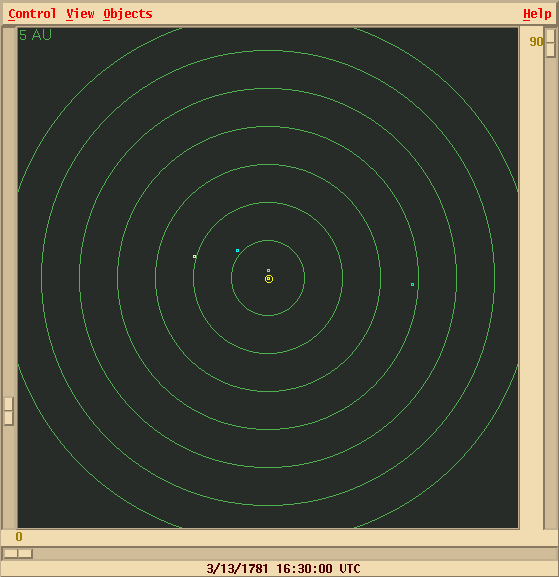
 Copyright © Michael Richmond.
This work is licensed under a Creative Commons License.
Copyright © Michael Richmond.
This work is licensed under a Creative Commons License.
For thousands of years, humans recognized a small number of objects in the night sky which moved against the backdrop of the fixed stars. We call them "planets." In addition to the Sun and Moon, five were known to the ancient world: Mercury, Venus, Mars, Jupiter and Saturn. In 1781, a professional musician (and amateur astronomer) named William Herschel discovered a new planet during his systematic sweeps of the heavens. We now call it "Uranus".
A bird's-eye view of the solar system from far above the plane of the ecliptic shows the location of Uranus at the time of its discovery (Uranus is the green dot near 3 o'clock, the Earth the white dot just above the Sun at center; Jupiter and Saturn are also shown).

Astronomers followed the motions of Uranus and the other planets over the succeeding decades. By 1845, Uranus had moved about three-quarters of the way around the Sun in its orbit:
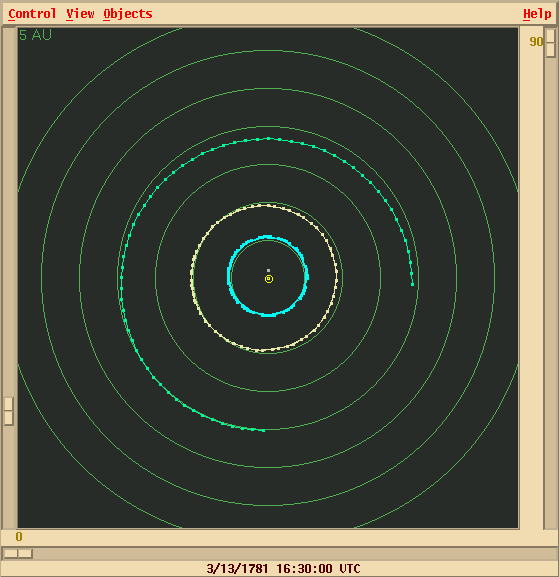
Thanks to Newton's Law of Gravitation, scientists could calculate exactly how the planets ought to move in their orbits. One can form an EXACT solution when there are just two bodies orbiting around each other: each moves in an elliptical path. The Sun is so much more massive than all the other bodies in the solar system that its influence dominates all motions. One can very quickly determine how a planet ought to move due to the Sun's attraction alone. Astronomers quickly discovered that their measurements were precise enough to show the very small perturbations to these ellipses. With a great deal of effort, it was possible to calculate the forces on each planet due to the Sun AND the other planets. Remember, this was way back in the days before computers, or calculators; the work took pencil and paper and days of drudgery.
During the 1820s and 1830s, a few astronomers noticed that Uranus wasn't quite following the expected orbit. Even after accounting for the influences of all the other planets, they could not predict its position precisely. The measured positions of Uranus were slightly ahead of the predicted ones for the first forty or so years after its discovery, and slightly behind the predicted ones for the next few decades.
What was going on?
Two young scientists, John Couch Adams in England, and Urbain Jean Joseph Leverrier in France, independently -- and unknown to each other -- considered the possibility that there was another planet, farther from the Sun than Neptune, which might cause the observed perturbations. If the planet started in just the right position, ahead of Uranus in their orbits, it would pull Uranus forward at first (from 1781 to 1802):
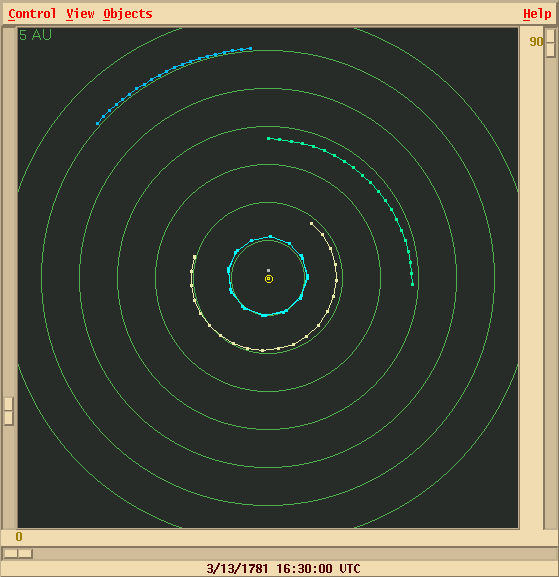
Then have little effect while Uranus passed it (from 1802 to 1823):
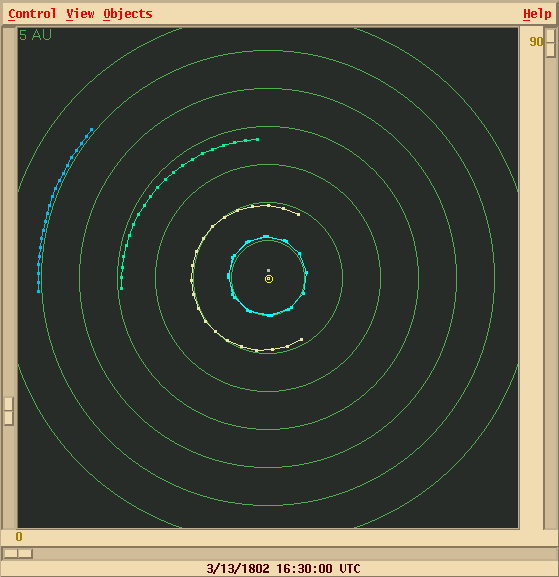
And later still (1823 to 1844), after Uranus had passed it, it would slow Uranus down:
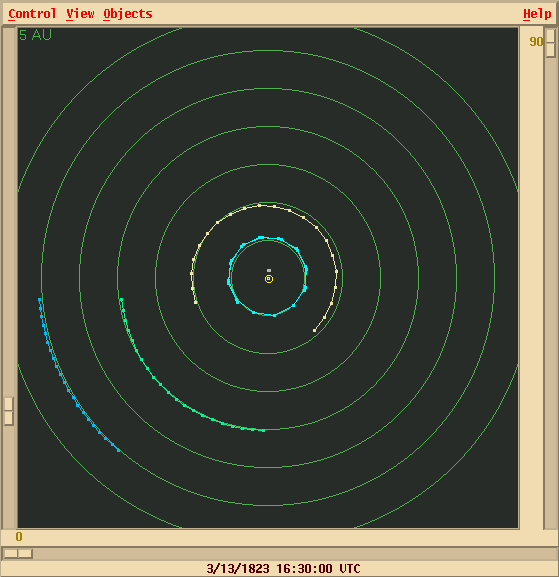
During the 1840s, Adams worked out where the new planet might be. In September, 1845, he wrote to Sir George Biddell Airy, the Astronomer Royal of England, asking for his help in searching for an object near his predicted position. Airy -- to be brief -- did nothing about it.
Leverrier, on the other hand, who started a few years after Adams, soon had a prediction of his own. In June, 1846, Leverrier published a paper in which he provided details of his work and a predicted position. His position was just two degrees away from that of Adams -- but he still didn't know of Adams' work. When Airy learned of Leverrier's paper, he asked a colleague to start looking for the new planet, but nothing happened for three weeks. In late July, 1846, one English astronomer (John Challis) started searching near the predicted position, following instructions from Airy:
July 29 Challis observes sky, notes positions of stars July 30 Challis observes sky, notes positions of stars Aug 4 Challis observes sky, notes positions of stars Aug 12 Challis observes sky, notes positions of stars ... additional nights through Sep 30, 1846
Challis would later realize that he had recorded Neptune on August 4, and on August 12 -- but just did not recognize it as a planet. Why not? Because he did not bother to compare his list of stars seen each night to each other; he just put the observations in a folder and left them for later.
Too bad, Mr. Challis.
On August 31, 1846, Leverrier (still ignorant of Adams' work) published another paper with an improved position.
On September 2, 1846, Adams sent an improved position of his own to Airy.
On September 18, 1846, Leverrier wrote a letter to a friend of his at the Prussian Observatory in Berlin, asking him to use the telescope there to search for the new planet at his calculated position. His friend, Johann Gottfried Galle, received the letter on September 23. Galle and his assistant, Heinrich d'Arrest, started work that evening. Galle looked through the telescope and called out the positions of stars, while d'Arrest checked them off against a chart.
Below is shown an area of the sky about seven degrees across, as it appeared on September 23, 1846. The view is similar to what one would see looking through a pair of ordinary binoculars. The bright object at the center of the field is Saturn. Adam's predicted position is marked with an "A", and Leverrier's position with an "L".
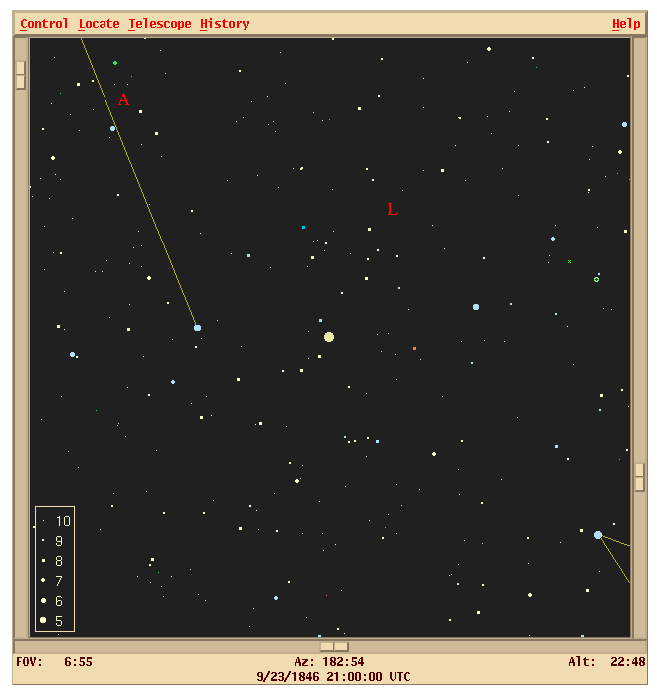
Less than an hour after they started, they found it: an object of magnitude 8 which was not on the charts:
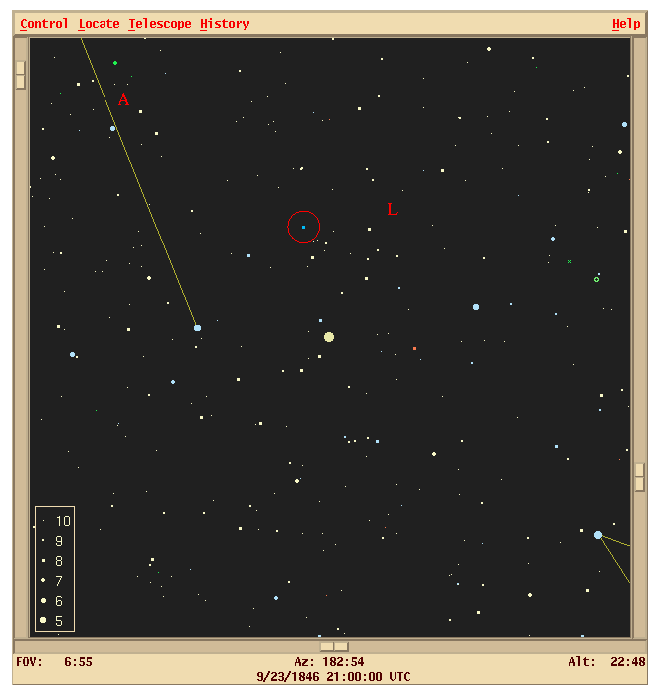
Leverrier was hailed as a hero, the discoverer of a new world, eventually called "Neptune." Eventually, Adams' work was also recognized, and today we consider both Adams and Leverrier to be the co-predictors of the eighth planet.
To be fair to Challis, Neptune really doesn't look very different from an ordinary star when viewed through a small telescope. The picture below shows images of the gas giants taken with a 180mm (about 7-inch) telescope.
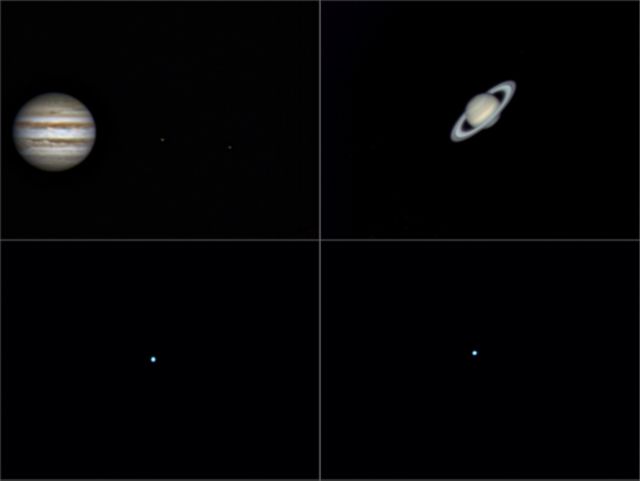
Images courtesy of
Mark Bell
For further reading about the prediction and discovery of Neptune, visit Mathematical discovery of planets.
 Copyright © Michael Richmond.
This work is licensed under a Creative Commons License.
Copyright © Michael Richmond.
This work is licensed under a Creative Commons License.